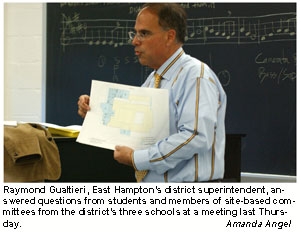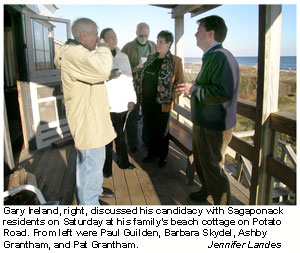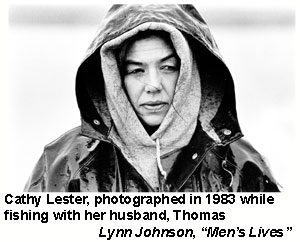Struggling To Make Films
Struggling To Make Films
What happens when a panel of international directors sits down before an audience of independent, up-and-coming, mainly American filmmakers to discuss the art they share in common?
First they take their jabs at the multimillion-dollar Hollywood picture industry.
"On a Spanish film you shoot with the budget of the transition scenes in an American film," Manuel Gomez Pereira of Spain said at a filmmakers breakfast during the Hamptons International Film Festival Saturday.
Then they concentrate on the more insidious tactics of the American movie establishment machine. Nicholas Philibert of France pointed out that "the major studios control the screens and they say [for example], 'if you want the last Clint Eastwood film, you also have to take this package of 10 films.' "
The Struggle
As a result, "98 percent of the screens in Eastern Europe are occupied by American movies," he said.
Surprising? Consider this. The percentages are similarly high in European countries with better known cinematic traditions than Hungary or Kazakhstan. Even in countries like France, Germany, or Italy, the majority of big screens are filled with Hollywood products.
"It is an essential struggle to even be able to make films," Mr. Philibert told the tent full of filmmakers.
The "struggle," the effort it takes to not only complete a film, but then find a market for it and bring it to a broader audience, was something nearly every director or producer in the festival's V.I.P. tent that morning could understand. Many had just completed their first features, some were still film students, and others were renowned in small circles but relatively unknown to the average movie audience.
The Directors
Mr. Gomez Pereira, who directed "El Amor Prejudica la Salud" ("Love Can Seriously Damage Your Health"), which earned an audience award at the festival for best feature film, was one of the filmmakers spotlighted in the festival's homage to Spain's largest production company, Sogetel. Ironically, his next project, a $15 million English-language film, is likely to be co-produced by Sogetel and a big Hollywood studio.
Mr. Philibert was one of three "outstanding international directors" whose work was featured in the festival. Three of his films, "La Ville Louvre" ("Louvre City"), "Le Pays des Sourds" ("In the Land of the Deaf"), and "La Moindre des Choses" ("Every Little Thing"), were shown here. Though he generally makes documentaries, Mr. Philibert's next film, "Who Knows?" will include actors. He flew back to Paris Sunday and was to begin shooting on Monday. The actors, he said, "will build themselves a story. It will be a sort of documentary about the birth of fiction."
Tribute was also paid to the career of Alejandro Agresti of Argentina, another of the panelists. Mr. Agresti's films "La Cruz" ("The Cross"), "El Acto en Cuestion" ("The Act in Question"), and "Buenos Aires Vice Versa" were shown at the festival.
Captive Film
None of them has received wide distribution in the United States and "El Acto en Cuestion," which he considers his favorite and most important work is, in a sense, a captive in Holland. It was paid for in part with a grant from the Dutch Government, and in part with funds raised by his producer, who went bankrupt after the film was completed.
Now the Dutch Government lays claim to the work, the bank that lent the producer money owns the rights to it, and Mr. Agresti is left with a single print of his favorite film, which he literally carries from festival to festival. He said his next film is to be called "Wind With a Gone."
Also on the panel at the filmmakers breakfast were Sandrine Veysett of France, the director of the opening night film, "Y'Aura-t-il de la Neige a Noel?" ("Will It Snow for Christmas"); Eric Heumann of France, who directed "Port Djema," and Martin Walz, a Swiss director whose "Kondom des Grauens" ("Killer Condom") was shown as part of the festival's "subversive cinema" program.
Political Climates
Chances are American audiences outside of film school haven't heard of any one of them. Like their sometimes younger American counterparts in the tent, some were still hoping their latest films would get "picked up," if not at this festival, maybe at the next.
One young director talked about how the rise of the conservative right in this country was affecting Americans' ability to make the art they chose to make and asked if changing political climates had affected the panelists' work or the choices they made.
Mr. Agresti, who had begun his career in one of the darkest eras of Argentine history, when disappearances and death squads were at their height, said, "When you think about what film you can make, then you make a political film." Working under a military dictatorship, he said, "I couldn't tell these little stories that I would be fascinated to tell because I was saturated with politics."
Sometimes, he said, it is under the most oppressive conditions that you "have the freedom to invent."
Do What You Want
In America "you have to write the same film, over and over." Mr. Agresti then related a clip from a documentary he had seen about the Czech Republic in which the interviewee said, "In Czechoslovakia you are influenced by the taste of one idiot. In American you are influenced by . . ." And Mr. Agresti paused, then added, "I could hear him thinking 'millions of idiots. ' "
Ms. Veysett, speaking through a translator, underscored Mr. Agresti's comments, telling her fellow directors at the breakfast, "If I have any advice it is to do exactly what you want to do."
"Don't accept money if you have to pay for that money by giving up your freedom," she cautioned.




